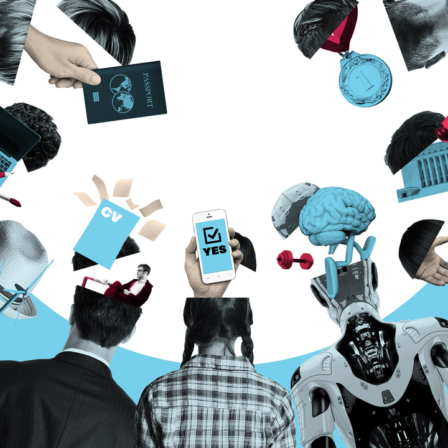While visiting Finland, Dave Snowden said that in 10 years’ time we will laugh at the fact that surveys were done using a scale of 1 to 5 for answers. Sini Vikkula and Sari Siikasalmi from consulting company Vimma entirely agree.
“If we ask a company’s staff members how satisfied they are on a scale from one to five, and satisfaction drops 0.25 percent from the previous year, what will we do with that information?” Siikasalmi asks. “The management team is sorry about it for a short while, but the information does not guide activities and it cannot be adopted into strategy.”
Vimma specialises in participatory management and the use of experience-based knowledge in management. The goal is to help businesses listen to their employees and clients.
However, businesses are often suspicious about open data.
Managers think it is too laborious or fear that it raises shortcomings that cannot be repaired. That is why they may propose surveys with suggestive questions to Vimma: “How have we already succeeded in the eyes of customers?” Often participation is encouraged just for show; the opinions of the employees are asked for although they will have no effect.
“If I expect to receive the answer I already have in mind, it is not a dialogue but a consecutive monologue. In dialogue, you ask a question and then really listen to the answer. You let the other person define the topic that has not been defined yet,” Siikasalmi says.
This is what Vikkula and Siikasalmi did when formulating the autumnal staff survey for the Salomaa Group, which partly owns Vimma. They gave the material an effective treatment with both SenseMaker and their own text tool, which analyses words and their connections.
In the work community, a culture of profits prevailed
Salomaa Group owns various media and marketing businesses, such as Dagmar, SEK, Voitto and Kaski. The group’s employees fill in a personnel survey four times a year.
This time, a situation was described for the respondents: “You sit at a bar with your friend after work. Tell them about a recent singular event or experience that describes, in your opinion, what it is like to work for us.”
During the planning of the survey, another formulation was also considered: “Tell us about a typical experience at your work place”. Siikasalmi and Vikkula rejected that one, as the respondents would only have looked for the correct answer.
“They probably would have described what they should do: ‘In my daily life, I help a customer improve their marketing.’ Or: ‘I made slides’,” Siikasalmi says and laughs. “We wanted a question that would get close to feelings and values. That is, what remains in our hearts from the work place.”
In the analysis, a community devoted to its workplace appeared. Almost one in every three had assessed their story as very positive, and 74 per cent thought that it expressed strong trust and a freedom of choice. Also, 76 per cent of the respondents regarded their organisation as flexible (narrative 1: see the narratives below this article) and free from hierarchy.
To an outsider, there was something negative in the stories, too: a feeling of hurrying and chaos, a need for helping hands (narrative 2) or a feeling that you should work even when sick. As much as a quarter of the stories have been marked secret and cannot be viewed by an outsider. One can only see their titles, such as: “Anxiety”, “When nothing is enough” or “From frost to frost heave ”. On the other hand, it was notable that many stories detailed gratitude felt for pleasant workmates, who helped others to carry on (narrative 3).
According to Siikasalmi, word analysis revealed a culture of profit (narrative 4). “Let’s win over new clients, let’s win over new people! The respondents were results-oriented and even used metaphors alluding to fast-paced factory work. ‘Units are hammering out results’, for example.”
“The advertising business is at a turning point. The old financing base has crumbled, and we have also had layoffs,” Sini Vikkula points out. “People might think that their employment equals the result they produce.”
Siikasalmi says the management team thought the results were pretty good. At the same time, they have to consider why subject matters were discussed so little, and whether innovations can be born out of such a busy culture of achievements.
“Something should be reorganised a bit in order to find space for creativity.”
Conceptualisation felt awkward
To Siikasalmi and Vikkula, the SenseMaker tool itself was a slight disappointment. They think it was too demanding on the user.
“Let’s assume we ask you what you did yesterday. You write that you had a roll for lunch. Next, we will ask you if your experience was about community, individualism or authoritarianism. What can you answer to that?” Vikkula says. “The tool creates a new conceptual level of the story, more linguistic over the linguistic .”
Vikkula and Siikasalmi received a lot of feedback saying that the survey was too difficult. Many respondents quit halfway through. “And this is an organisation of educated experts who are used to conceptual thinking,” Siikasalmi points out.
“The conceptualisation makes the method very discriminatory,” Vikkula adds. “This could not be used in real public participation.”
Part of the problem is, of course, not being familiar with the method: triangles look strange to people, and they are not used to analysing their stories. Siikasalmi and Vikkula also admit that they should have explained the purpose of the triangles better and left out the highfalutin references to the University of Bangor.
And, ultimately, the best way of using SenseMaker is not for replacing typical surveys, but for collecting experiences.
Siikasalmi and Vikkula remain interested in the other methods of Cognitive Edge, such as an organisation’s new employees keeping a diary. “Interpreting photographs could also be nice,” says Vikkula.
“For instance, people could photograph their daily life. Take five photographs depicting the relationship between them and their home town,” Siikasalmi suggests.
“Oh, what a lovely idea! Let’s sell that to the city of Helsinki!”



Latest